#folklore facts
Text
Werewolf Fact #72 - Returning to Human Form
Time for Werewolf Fact #72! Wow, that's a lot. And that's not counting all the books and articles and ask responses and other things I've done over the years. It's been a fun ride.
But for now, let's turn our attention to something a patron pointed out I've never actually discussed... what makes a werewolf return to human form?

I'll be honest: popular culture has taken much more of an interest in laying out the details about returning to the human form than did folklore, overall. In folklore, the act of changing to and from was certainly the centerpiece of the horror, but popular culture and its emphasis on werewolf characters led into a deeper evaluation of such an experience. Folklore also generally discussed the transformation into a monster much more than out of it, at least in more laborious and horrific detail (see Lykaon, Niceros, etc).
We see painful transformations to the werewolf form in folklore quite a bit, as I've discussed before. In fact, the prime example is one of the earliest surviving recorded werewolf legends. And yet even turning into the bestial form was occasionally painless in folklore, involving donning a magic skin or performing a simple ritual to suddenly become a wolf. As for the werewolf returning to the human form, as far as folklore is concerned, that often seems almost or entirely effortless.
Obviously, in popular culture, it's much more common to have the dramatic to or from in either form. I'm personally a big fan of this, as you'd know if you've read any of my fiction (be sure to check that out at my website!), but if you really want to get down and dirty with werewolves being true to folklore, frankly it is overall common for neither transformation to be painful. And certainly it is even less common for the return to human form to be a particularly traumatic or jarring event. That doesn't make for a super dramatic story, though, so we see - especially in past werewolf stories, ones that emphasized horror more - the traumatic tos and froms.
With that out of the way, here are some methods of returning to the human form in folklore...
End of certain timeframe - The most common of triggers to return to the human form, many werewolves will reassume the human form after a certain amount of time has passed. For instance, werewolves in Greek myths like those of Arcadia could return to their human form after seven or ten years, if they hadn't devoured any human flesh. Likewise, other werewolves would return after a certain number of days or even weeks had passed, with or without other circumstances.
At will - There are cases of the werewolf returning to human form at will throughout folklore, or else it is unspecified if there are any other required circumstances or acts.
Removing the magic skin/item - This can vary from being difficult (such as with Sigmund and Sinfjotli) to being as easy as "peeling back the wolf skin," such as in the tale of the werewolves of Ossory. There are many other examples as well, with varying degrees of difficulty or triggers.
Using a salve - In some stories, a salve is rubbed on the body to reassume the human form. This is also the case with assuming the wolf form. This is more common in the Renaissance/Early Modern period, overall, often with Satanic werewolf or even witches-rebranded-as-werewolves-by-modern-scholars, though there are a few cases otherwise.
Putting on your clothes again - In some stories, a werewolf who sheds his clothes turns into the wolf form, and in order to don the human form once more, he must return to his clothing. Sometimes, the clothes turn to stone in the meantime, until he returns to put them back on. Or, such as with Bisclavret, the clothes may be hidden, trapping the werewolf in bestial form.
Curse removal - In some stories, whoever cursed the werewolf must lift the curse in order to return the werewolf to human form. This is the case in tales wherein the werewolf doesn't go back and forth at all but is someone cursed to become a wolf and stay that way until said curse is lifted, less like a traditional werewolf.
Daybreak - Some werewolves returned to the human form at daybreak. While this didn't appear in stories directly very often, it is mentioned in assorted sourcebooks, such as Baring-Gould and Summers discussing werewolves and how "the desire comes upon them at night." It can also be speculated based on events in stories, such as Niceros's Tale, but the circumstances there were never explicitly stated. So this one may be slightly more questionable than the others if you want direct story sources, but I'd say there are plenty of sources around enough to justify it being on this list.
I am not including those funky ones you see all across the internet that weirdos bandy about in their clickbait list articles, like "tossing iron over the werewolf's head" or whatever, because I need a lot more cross-referenced actual examples of those to include them in a list such as this, as opposed to unfounded Google results that D&D players then like to grab and turn into le silleh memes.
Note that this list, as always, doesn't cover every single possibility seen in folklore. I'm not even going to pretend I'm trying to do that here. That will be in the future Werewolf Facts book that I'm publishing in a few years (yes, I am working on that).
And that just about covers the general overview! Hope you enjoyed the post. Be sure to check out the links below. Until next time!
( If you like my blog, be sure to follow me here and elsewhere for more folklore and fiction, including books, especially on werewolves! You can also sign up for my free newsletter for monthly werewolf/vampire/folklore facts, a free story, and book previews.
Free Newsletter - maverickwerewolf.com (personal site + book shop + free fiction) — Patreon — Wulfgard — Werewolf Fact Masterlist — Twitter — Vampire Fact Masterlist — Amazon Author page )
#werewolf#werewolves#werewolf fact#werewolf facts#werewolf wednesday#werewolfwednesday#folklore#folklore facts#mythology#wolf#wolves#lycanthrope#lycanthropes#lycanthropy#shapeshifting#shapeshifters#resources#popular culture
56 notes
·
View notes
Text

#i literally had no other reason to make this gif other than the fact that she looks devastingly gorgeous here#idk if one gif is even worth tagging everyone so😭#anyways my fav (folklore) taylor in her full glory<3#taylor swift#the eras tour#sydney n4#tswiftgif#tswiftedit#tswiftdaily#tswift#eras tour
908 notes
·
View notes
Text


fairy ring fungi 💖🌟
This is the herbologist reward for April! If you'd like these postcards as well as three pages worth of fairy ring fungi folklore and facts, consider joining my patreon for this month - a handful of slots are free!
#fungi#mycology#mushroom#mushroom art#fairy ring#folklore#botanical art#seriously i got sooo nerdy#i wrote 1100 words on fairy rings and their folklore and sciency facts#ahhhh i love being a nerd
667 notes
·
View notes
Text

Happy Krampusnacht!
Don't go to the forest alone tonight.
#Fun fact! I made this edit in one layer!#Also PSA: I have some limited christmas merch! Check my previous post for details 👀#krampus#folklore#photoshop
549 notes
·
View notes
Text
When AI is so prevalent everywhere nowadays that even Death starts to invest in cheap grim reaper robots /j (that keep eventually gaining sentience and becoming spiteful and lost spirits but shhhh, that's too much lore)
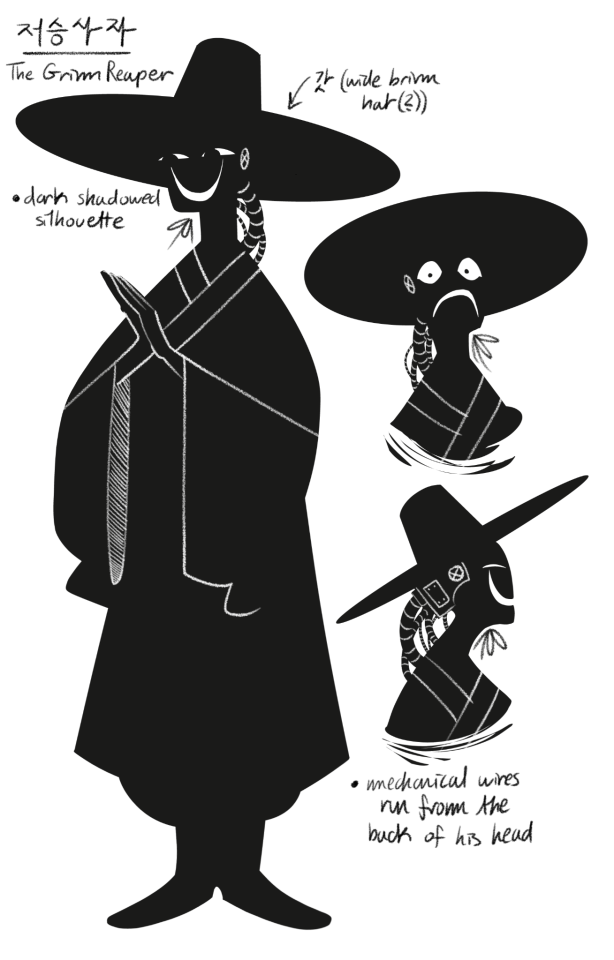
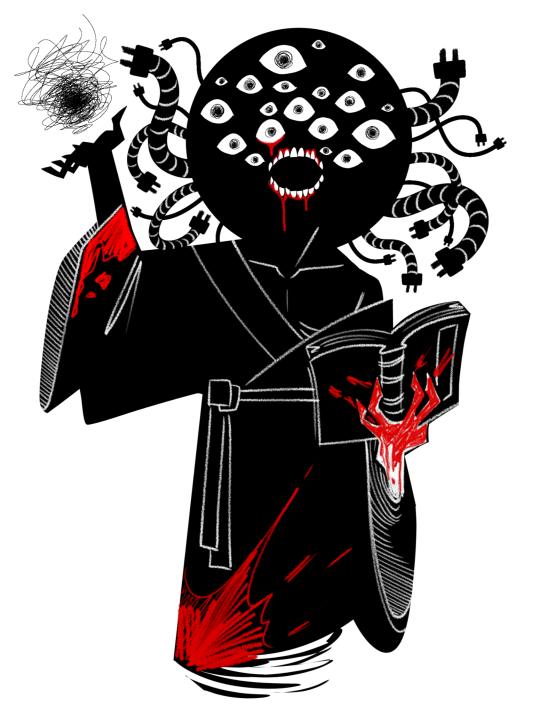
Inspired by the Korean folk lore of Death: 저승사자- a psychopomp deity who's job is not to judge or kill, but to simply guide newly deceased souls to the afterlife. They are traditionally depicted wearing a black (한복) hanbok with a black (갓) gat.
#Here's your daily cultural fun fact ig!#let's combine otherworldy deities with mahcanical body horror eyyyyy#my art#artists on tumblr#death#grim reaper#death design#character design#저승사자#korean folklore#korean culture#tw body horror#tw staring#tw scopophobia#tw blood
124 notes
·
View notes
Text

I think I can, I think I can, I think I can!
#live from tidmouth#creative on the mainline#ttte#thomas and friends#thomas & friends#thomas the tank engine#tamtr#thomas and the magic railroad#ttte lady#lady the golden engine#cp huntington locomotive#fun fact. the little engine that could's design was inspired by cp huntington#So! CP Huntington Lady! I thought that considering that she's from the States#an American basis would suit Lady a little bit more...#Is this the American version of the folkloric figure#or the real Lady?#up to you but i think i like this design too much to NOT draw it again
75 notes
·
View notes
Text
listening to hoax rn and what struck me about the chorus is that she is implying that this faithless love is the ‘reason’ she needs in order to stay on the cliffside instead of driving off (a parallel to this is me trying imo), yet the song makes it clear that this same thing has ‘frozen her ground,’ turned her into ash, killed the hero in the movie. in taylor’s own words, the song is about three different situations, and perhaps the only thing they have in common is that they all involve people she loved and let into her life (‘you knew the password so I let you in the door’) who ended up betraying her in a way that felt comparable to the greatest pain of her life. the difference is that the other two muses (a business situation and a ‘relationship that was like family’) are now out of her life, but she clings to this love as the one thing that keeps her going even if she has to resign herself to eternal sadness (‘don’t want no other shade of blue but you / no other sadness in the world would do’ —> ‘gray skies, every day, for months, would you still stay?). idk hoax is a lot of a lot.
#this killed her and it also brought her back to life#how do you let go of that#think I was scared to fully dive into this song bc it confused me for the longest time#and considering the fact that the relationship was ongoing at the time it just felt like a lot#but yeah#hoax#folklore#this is me trying#ttpd
64 notes
·
View notes
Text
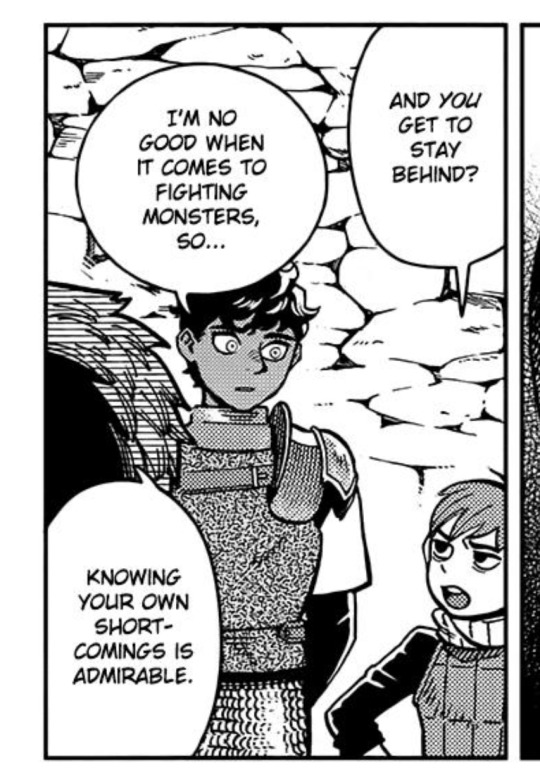
Here is the truth! Kabru, being trained from a young age in swordmanship by a navigated warrior, knows that fencing is useless against monsters. Laios and the gang seldom used weapons to defeat their preys.
Think about it: swords have been the first weapon not born as a tool or a hunting implement, with the specific purpose of killing other human beings. There is a well tought out rationale behind the shape and form of a sword and they informed how weapon systems developed in time and space to take advantage of it, and vice versa. The all metal, tang thru the handle contruction of a conventional sword gives a tactile response everytime any part of the blade touches anything, a level of resolution not needed if you are up against a beast, but fundamental against a fellow smart human being armed with a weapon you need to track. That feeling of the iron is useless if you can't bind, and you are not binding horns nor fangs let me tell you.
Kui-sensei is so real for aknowledging this fact that is driving me crazy for years. Swords are a shit choice against beasts and monsters and I kind of despise fantasy tropes for spreading the idea.
#kabru dungeon meshi#kabru#swords#fencing#this rant is offered to you by a two hours long tie guan yin tea session#and years of thinking about swords#yet the genre tropes are ther because swords were so rare that the common man didn't know what they really were for#so myths and legends for centuries have painted them as a godly weapon only fit for noble heroes and kings#the folklore wins over facts
93 notes
·
View notes
Photo

Death for Koshey
#artists on tumblr#folklore#Koshey#Koshey the immortal#not for long though#my art#im sick of the fact that some of my friends weren't able to outlive him#i hate it#this was drawn on power of hate and greif
306 notes
·
View notes
Text
The Crow and The Robin


"And the Raven, never flitting, still is sitting, still is sitting On the pallid bust of Pallas just above my chamber door; And his eyes have all the seeming of a demon’s that is dreaming."
“I’m man’s inedible
Permanent bird.
I dine in his garden,
My spoon is his spade.”
I find extremely interesting the association of Sebastian with crows/ravens and Ciel with robins, amongst the various meanings and interpretations we have of course death for crows and fire for robins. But what really captivates me is how both birds have a myth regarding how each got to be the colour they are today.
Ravens, once white, were scorched by Apollo, while Robins got their signature red chest by removing one thorn from Jesus's crown and stabbing themselves.
Divine Punishment and Self Inflicted Wounds.
Truly interesting...
#i just love these lil things#i don't even care if I'm reaching and Yana didn't actually mean anything by this#i mean i doubt she hadn't done some research but still#also fun fact but Robins too are tied with death#it is said in some folklore that if you hear a robin tapping on your window that is a sign of death#and what does ciel do? he kills people for the Queen#it is also said that destroying a robin's neat will bring harm to your hands or a fire to your house and listen what did Ciel?#made Sebastian set shit on fire exactly#sebaciel#kuroshitsuji
60 notes
·
View notes
Text
Werewolf Fact #69 (dude!) - Ancient Egypt
Well, I thought this month would be about something else, but my patrons spoke differently! And I always listen to my patrons when it comes to folklore facts.
So, without further ado, let’s finally get back to werewolf facts! This is a big one, as it’s a lifelong favorite topic of mine!
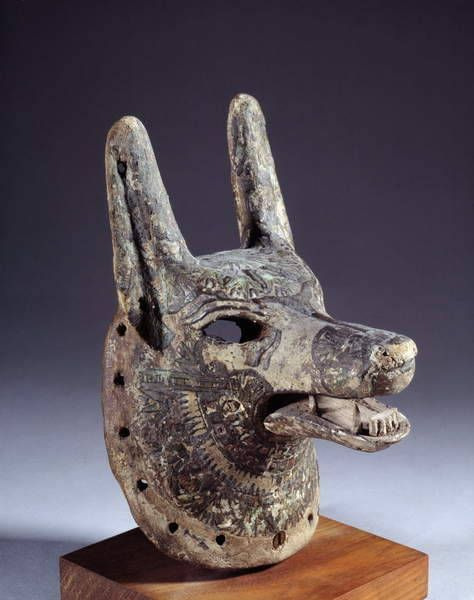
An ancient Egyptian mask worn by a priest during rites performed for the dead, who would have “taken on the aspect” of the wolf-headed god Anubis
Let me just open by saying that I absolutely love ancient Egypt. It’s fascinated me since I was a small child and I was reading a tiny children’s book about cats, and ancient Egypt was discussed. Naturally, when I found out about Anubis, I was even more interested. Then came games like Age of Mythology and many movies... especially The Mummy (1999), of course. Anyway!
Ancient Egypt didn’t have a negative opinion of wolves. In fact, several important deities had wolf heads and were associated with wolves. Let’s begin with something that’s always interested me, which is the city of Lykopolis (as it was called in Greek)...
More under the cut, since this post got so lengthy!
Lykopolis (ancient Egyptian transliteration is something like “Zawty”) was an important city located on the western bank of the Nile, capital of the Thirteenth Nome of Upper Egypt during about 3100 BC. The primary deities of the city were - as you might imagine - Anubis and Wepwawet, both wolf-headed gods. Mummified wolves (golden wolves, not jackals; more on this momentarily) have been found in various excavated chambers throughout the city ruins, of which very little still survives.
The city has a very fun story behind it, as told by Greek historian Diodorus Siculus. In the first century BC, an army of Nubians invaded from the south - but they were repelled by packs of wolves. These wolves drove the army from the southern borders of Lykopolis and then back beyond the borders of Egypt. According to Diodorus, this is why Lykopolis was called “the city of the wolf” and revered wolves and wolf-deities so greatly.
Some sources claim that these wolves were summoned by the god Osiris, who was also worshiped as a wolf in Lykopolis, and had also, at one point, taken the form of a wolf. I will admit I personally haven’t read this source, as it’s in French, so I can’t fully attest to that element of the story - I haven’t seen that one cited very often in various specifically ancient Egypt history sources. Regardless, it’s fun if true. Either way, the tale of the wolves driving back Egypt’s enemies was definitely recounted in detail in a primary historical source!
By the way, you’ll hear a lot of people refer to these deities as “jackal-headed.” It’s very popular still to call Anubis the “jackal god.” We now know, though, that the animals in question were in fact not jackals - they were indeed wolves. Scientists for a long time asserted that they for some reason knew things better than the ancient Egyptians and Greeks who actually lived during the time period and retroactively dictated that they weren’t wolf gods, they were jackal gods.
However, the Egyptian jackal was discovered to be a species of gray wolf. You can read a lot about that here in this article, regarding how people didn’t believe wolves lived in the area during those time periods, but we found out they did, and we also found out that the mummified wolves in Lykopolis were - yes - wolves, like their contemporary cultures said.
A quote from the article: “the Egyptian jackal is in fact a gray wolf. ‘We now know that wolves were indeed in Africa in the days of the ancient Egyptians—and long, long before,’ says Stenseth.”
I honestly don’t know why everyone thought wolves couldn’t have lived in the area during these time periods (when we know perfectly well a wide variety of animals inhabited regions they no longer inhabit, and that we discover new species in the deserts even to this day) or decided the ancients didn’t know what they were talking about, but anyway...
Another fun fact, by the way, is that the word “jackal” didn’t even enter the English language until the 1600s, borrowed from French, which in turn was most likely borrowed from Persian - not Egyptian. The animals in Egypt were wolves, and we now know that they were also wolves scientifically. In fact, some scientists even believe it’s possible that jackals (as in actual scientific jackals, not golden wolves) didn’t find their way into the Egyptian region until much later, when these wolf gods would have been well-established. They may have followed travelers out of Arabia. This is speculation, though, but regardless, the long-believed-to-be “jackals” of ancient Egypt were all wolves. So it sounds like we should’ve believed the ancient Egyptians and Greeks in the first place, huh?
Long story short - Lykopolis was indeed a wolf city, wolves drove invaders out of Egypt, and Anubis, Wepwawet, and Duamutef were wolf gods. Not jackals.
Please note that there are those who would argue with me that some of them are jackals and some are wolves, or that they were all jackals, or whatever else, but in my personal opinion (and the opinion of many historians and scientists), it’s very clear across depictions, mummified wolves, historical accounts from both Egyptians and Greeks, etc., that these many Egyptian wolf-related beings were what we now call “golden wolves” or “Egyptian wolves” (and sometimes referred to as “jackals” still despite their genetics), which are indeed gray wolves, and not a species of true (genetic) jackals. There also exist theories that these wolves are something that no longer exists, and also that the modern animals we have are interbred wolves and jackals. Theories abound, whatever the case.
Then of course there are those who say that Anubis was the jackal-headed god and Wepwawet was the wolf-headed god, due in no small part to inherent biases that wolves only come in “gray.” I think those are all very silly, especially as we already know that colors in ancient Egypt were highly associated with ritual and meaning, rather than directly stating that Anubis’s head was black because he’s some kind of black-backed jackal - which don’t even have black heads, anyway. We have multiple associations between Anubis and wolves, and just because Wepwawet was often depicted with a grey or white head doesn’t make him a wolf and Anubis something different. Therefore, I personally will continue to refer to all of these as wolf-headed gods, and I apologize if that bothers anyone.
Sorry. Brief Mav-rant there. More important things to follow, because we haven’t even talked about those deities yet!
So now let’s talk about these gods themselves...
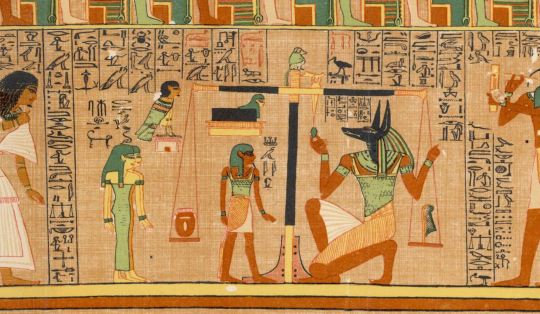
Anubis in the book of the dead (which was not actually a book)
Easily my favorite thing in all of ancient Egyptian mythology, Anubis (known by many other epithets, including but not at all limited to "Lord of the Sacred Land," "He Who is Upon his Sacred Mountain," "Master of Secrets," and "He Who is in the Place of Embalming”) is the god of the dead. He was the protector of graves, guardian of the dead, the shepherd of souls passing into the afterlife, and many more roles, including the ever-important Weighing of the Heart (as seen above), the results of which would dictate whether or not someone was allowed to enter the afterlife - or if their heart was devoured by the monster Ammit and their soul destroyed forever.
Anubis was depicted with the black head of a wolf. His head was colored black because black was the color associated with life, the life-giving soil of the Nile River, regeneration, and embalmed bodies, and he, of course, is also the god of mummification. Anubis is one of the single most important deities in all of ancient Egypt, depicted and mentioned very frequently, even more than most any other deity - however, despite this, there are almost no stories actually involving him.
But no, Anubis was not “evil,” as much of modern pop culture would have you believe! (Sorry The Mummy Returns, I love you to death, I really do - but it was super rude to make Anubis evil.)
Long story short, Anubis was freaking awesome, and there’s way too much to say about him and his awesomeness for just one post. Maybe I’ll do a separate post all about him later, because he’s a personal obsession of mine.
Anubis’s brother (at least, he is considered to be this by some) was the god Wepwawet, another wolf-headed deity. Wepwawet was a man with a white or grey head of a wolf (though some think he may have also had a black head like Anubis, but others claim that is not the cause and the coloring was on purpose as we have seen it in too many different places - still more claim it was just the artist’s preference; it’s hard to know any of these things for sure)...
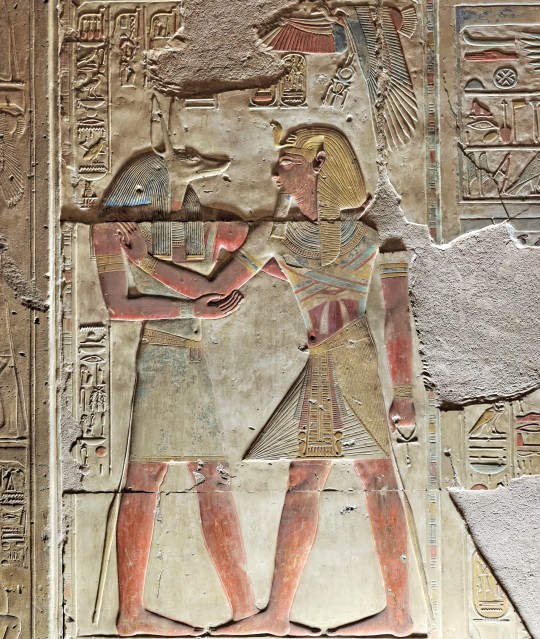
Wepwawet with Pharaoh Seti I (try not to read that in Ardeth Bay’s voice, I dare you. I don’t know why you wouldn’t want to, though)
Like basically all deities of ancient Egypt, Wepwawet is a complicated god, a deity involved in some funerary rites, but especially associated with war and royalty. Wepwawet means “opener of the ways,” and he was depicted as a man with the head of a grey or white wolf, as well as wolf at the prow of a solar boat, sometimes said to lead armies, to scout, and even to have the honor of going before the pharaoh himself. He is also known by the title “one with sharp arrows more powerful than the gods.”
A very important god, Wepwawet is one of the oldest gods of Egypt ever recorded, and he was always associated directly with royalty and specially the pharaoh. He was said to accompany the pharaoh on his hunts, as well as protecting the pharaoh in life and the afterlife - he is a symbol of divinity of rule and of kings in general. He is, for certain, a very good deity, rather than some kind of evil wolf of Western literature.
And lastly among the prominent wolf-headed deities, we have one of the four sons of Horus, Duamutef...
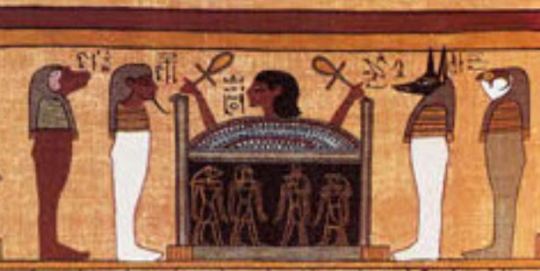
The four sons of Horus were depicted upon the canopic jars (jars containing certain organs of the mummified dead) starting in the First Intermediate Period of Egyptian history, which was around 2181-2055 BC. Each deity protected a different important organ; Duamutef, the wolf-headed god, always protected the stomach and represented the direction of the east. Please note he was not always depicted with a black head like Anubis; sometimes he also had a white or grey head. It varied. Likewise, in later periods, the forms of these various gods were sometimes mixed up, and a different son of Horus would have the wolf head. These deities were depicted not only on the canopic jars, but also on many other funerary artifacts, including the sarcophagi that would contain the jars.
So we have all these wolf-headed deities... but does any of this tie into werewolves at all?
Well, it doesn’t, really. There seems to be no indication that Anubis, Wepwawet, Duamutef, or anyone else did any particular shapeshifting, and they certainly weren’t cursed. They were gods. Anubis and Wepwawet are both sometimes depicted as simply a wolf as opposed to a wolf-headed man - as many of the Egyptian gods are depicted as their animal counterparts, including Ra, Horus, Hathor, Sobek, and many, many others - but that’s merely his animal aspect counterpart. Depictions and aspects of the gods of ancient Egypt (and also, later, how Rome and Egypt intermingled some of their deities during the Roman occupation, such as Hermanubis) are extremely in-depth topics. I’ve always loved studying them, but they are immensely complicated - certainly far too complicated for this post! So let’s get back to the matter at hand...
I’ll be honest, I have yet to find a credibly-sourced legend that talks about anything like an ancient Egyptian “werewolf.” I’m pretty darn sure they didn’t have anything remotely like what we consider among actual werewolf legends, my friends, and especially none that meet my personal criteria. The ancient Greeks, however, absolutely did, as you probably know if you’ve spent time browsing my werewolf facts masterlist (link at the bottom of this post!).
Wolf-headed gods, however - yes, they definitely had those, and no, they were not “evil gods.” In fact, some of them were very highly revered and associated directly with necessary aspects of life and death, as well as with pharaohs.
Speaking of, if you love ancient Egypt (and also adventure movies), you should absolutely check out my new novella that came out just this past June - Wulfgard: The Tomb of Ankhu!
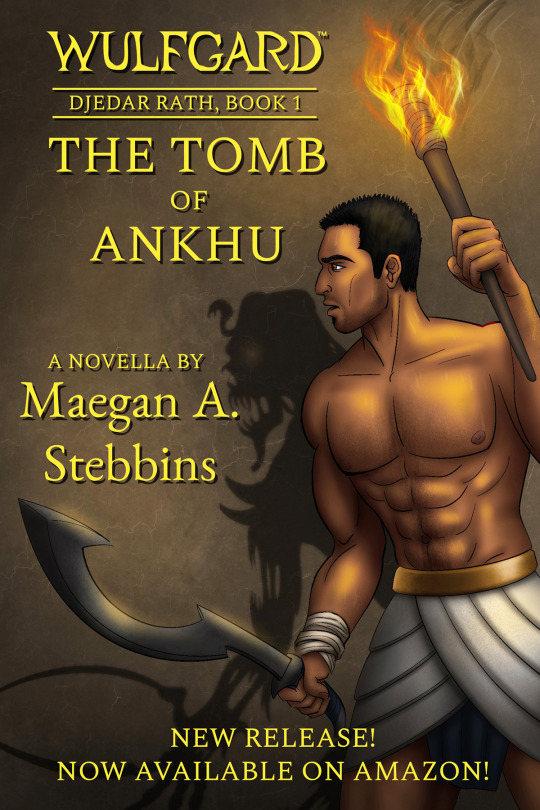
It is the first of two short novellas that tell an exciting tale about adventure, an ancient curse, mummies, memorable characters, and last but not least lots of Anubis and other legends, all of it set in the vast ancient-medieval dark age fantasy realm of Wulfgard: a world where all myths are true.
Every book release means the world to me, and this one is no different. I’m very proud of this story, and I really think you’ll enjoy it.
Deep in the southernmost deserts of Wulfgard lies the resting place of Pharaoh Ankhu the Endless, one of the greatest evils the land of Kemhet, or the world, has ever known. So terrible was his power that the gods themselves cursed him, sealing him away in an underground labyrinth. Ankhu rises with each darkening of the moon, a walking mummy, wandering this tomb in search of his own still-beating heart, without which he can never reach the afterlife.
Over untold ages, Ankhu’s tomb remained undiscovered, a secret protected always by the loyal Medjai, an order sworn to guard Kemhet from all threats. And now, a new threat has arisen: Lord Tefnahkt the Red, a powerful warlock, drives his cult and his many slaves to uncover Pharaoh Ankhu’s resting place and steal the mummy's power.
While a small group of Medjai desperately work to stop Tefnahkt’s plans, one slave may become the key to putting an end to this evil once and for all: Djedar Rath. In a race against time, Djedar must lead the Medjai to prevent Tefnahkt from opening the tomb of Ankhu before the coming of the new moon, when the undead Pharaoh will awaken once more. For, if Ankhu escapes, the world will never survive his wrath.
Inspired heavily by real-world ancient Egyptian and other mythologies - but with many original additions and elements - as well as the classic character-driven adventure genre that mixes aspects of action, thriller, and horror, with a tasteful sprinkling of levity, The Tomb of Ankhu is a tale of non-stop adventure and excitement that will leave you on the edge of your seat! Now available in ebook and paperback!
Go here to purchase on Amazon! https://www.amazon.com/dp/B0C8897R1K
Readers have been really enjoying this one! The second one has been in the works for quite some time already, so expect news about that in the coming months, as well.
Hope you enjoyed the werewolf fact this month, even if it was kind of more a wolf fact. But, myself, I have spent my entire life captivated by ancient Egypt, so I love this kind of stuff.
Thanks for reading, and until next time!
( If you like my werewolf blog, be sure to follow me here and check out my other stuff! Please consider supporting me on Patreon or donating on Ko-fi if you’d like to see me continue my works, including my folklore blog and writing my own novels, werewolf and otherwise. Every little bit helps so much.
Patreon — Personal Website (new and improved! Great starting point!) — Ko-fi — Wulfgard — Werewolf Fact Masterlist — Twitter — Vampire Fact Masterlist )
#werewolf#werewolves#werewolf fact#werewolf wednesday#werewolfwednesday#werewolf facts#folklore#folklore facts#mythology#mythology facts#ancient egypt#egypt#egyptian#ancient egyptian#anubis#wepwawet#wolf gods#wolf mythology#wolves#wolf#legend#legends#ancient world#osiris#ancient egyptian gods#egyptian gods#long post#research#lykos#jackal
76 notes
·
View notes
Text

#coquette#pinterest#coquette asthetic#girlblogger#coquette core#girlblogging#coquette blog#this is a girlblog#coquette girl#girl blogger#taylor swift#lily rose icons#lily rose depp#lily depp#cardigan taylor swift#girl facts#girl core#me core#folklore#folklore taylor swift#im just a girl#girl blogging#blogger#blogging#music addict#coquette dollete#coquette style#kate moss#blog#it girl
63 notes
·
View notes
Text
Short Prompt #57
The vampire shrunk back against the frozen hearth, their dying attempt at a fire trickling smoke against their ankles before another chill chimney draft snuffed it out completely. “I-I’m sorry. I didn’t know anyone lived here. I was just…just…”
What? Fleeing? Hiding from the angry mob combing the woods for them? There was no good way to explain this to the person in front of them without being suspicious. And what would being thrown out get them? They weren’t sure they they could avoid the hunters any longer.
The cabin’s owner only continued to stare. They were mostly shadowed, but their stance wasn’t particularly afraid. More…watchful. Like a cat observing it’s prey before it decided whether to pounce. That made no sense though. The vampire was the one here with supernatural abilities and a thirst for blood.
“There’s a warmer room upstairs if you want it. Though I’ve never known a vampire to shrink from the cold.”
The vampire jolted. “How did you—“
“There’s an entire mob tramping through my gardens.”
Their voice resonated like ice water in the vampire’s already dead chest cavity, tone chillingly even and whetted to a fine point.
“Right…”
“Besides, you vampires have such a sweet smell, like rotting roses. I knew you before I even walked through the door.”
That…wasn’t…normal…
Their neck prickled with some sort of instinctual warning, but even if they saw a way out, they couldn’t just leave.
“Probably best if you don’t step outside anytime soon,” the stranger said as if reading their mind. “They’ve doused half the forest in rice. A waste if you ask me, but not the worst way to win a battle without confrontation. They may regret it when deep winter sets in though.”
The vampire swallowed. They imagined being caught in that endless, hopeless loop of counting, gathering rice for hours and hours until the sun crept up and turned them to ash.
They shuddered.
“So why the mass hunt?” The stranger said when they didn’t respond. “I haven’t seen a group like this in at least a century. What makes you so special?”
Wasn’t that obvious?
“I-I’m a monster.”
The stranger’s eyes flashed yellowish in the dark, a smirk creeping into their voice as they stalked in closer. “Honey, you’ve never met a real monster.”
Part Two
#prompt#writing prompt#short prompt#vampire#vampire x monster#monster x vampire#supernatural#fantasy#dark fantasy#writblr#writeblr#creative writing#so fun fact#some vampire folklore says#if a vampire comes across rice or seeds scattered on the ground#they will compulsively need to count each grain#delaying them until sunrise#always thought it was a pretty fun idea#fantasci#fantasci tumblr
539 notes
·
View notes
Text
I love the swiftie new album ritual of being disappointed she's making a pop album instead of a rock album despite the fact she is a pop artist who has never given any indication of wanting to make rock music
#i can love it because i am seemingly the one taylor fan on this earth who is in fact not interested in a rock album from her#i already got my dream genre from her with the folk influence on folklore/evermore so now i'm just vibing#but it's so funny to me how the exact same reaction happened with midnights where everyone was like 'a pop album?? 🤨😒'#as though pop isn't clearly her default genre since like red#talking#taylor swift
38 notes
·
View notes
Text
Cold was the steel of my axe to grind
For the boys that broke my heart
Now I send their babies presents


#brocedes#the fact that Lewis gives nicos daughters Christmas presents still haunts me#taylor swift wrote half her discography on them#she told me so#they devastate me so much#I think about them every second and just feel pain#they owe me so much therapy#invisible string is so brocedes coded#folklore is so brocedes coded#everything is so brocedes coded#lewis hamilton#nico rosberg
39 notes
·
View notes
Text
So I've seen people in the fandom do it for their country, I loved so much the idea I did the same (i'm very influencable).
(Based on the lore/maps of the webcomic "Stand Still Stay Silent")




Even if I did know it could not fit the canon, I tried my best to do the more accurate (non-canon) lore for french territory.
I will maybe do a part 2 but not now, I will talk more about the infected and the Basques language.
The Tarasques are the french equivalent of the Trolls, I didn't have the energy to add other pages of information. (one day maybe)
I also wanted to mention the Dahu in the type of infected beast. (Yes there are Dahus, and that's is the best thing to know about infected beast, THERE ARE DAHUS INFECTED BEAST PEOPLE.)
______________________________________________________________
(Also can't spell in english so that's not very well written lol)
(Please note I'm just doing this for fun and it's a very rough/sketchy idea and I didn't take time to well adapt everything or even have a stylise coherence)
#AtalanteArt#my artwork#sssscomic#stand still stay silent#Stand still stay silent comic#stand still stay silent fanart#fanart#Summer bear art#webcomic fanart#digital art#fanmade#fanmade map#artists on tumblr#pyrenees mountains#french folklore#fun fact#did you know until 2015 Icelanders could murder Basques legally#well now you know#it's because of whales#I passed to much time on this stuff#I think I hyperfocus on the task and forgot time exist#Half of the clean area are places I've been and the other is random#Gavarnie is very nice#love this place#Also#so sorry if there are any mistakes in English#I can't spell lol#(neither in french and english)#love dyslexia#and my dumb ass
145 notes
·
View notes